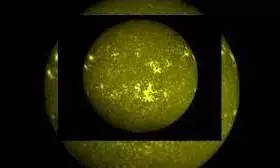
India's Aditya-L1 mission captures first-ever full-disk images of Sun
text_fieldsBengaluru: India's Aditya-L1 Mission has achieved a remarkable feat by capturing the first-ever full-disk images of the Sun, unveiling previously unseen details of the Sun's photosphere and chromosphere.
The Indian Space Research Organisation (ISRO) shared this groundbreaking discovery, showcasing images taken in near ultraviolet wavelengths.
The Solar Ultraviolet Imaging Telescope (SUIT), a pivotal instrument aboard the Aditya-L1 spacecraft, was responsible for capturing these images within the wavelength range of 200-400 nm. Utilising various scientific filters, SUIT provides a comprehensive view of the Sun's photosphere and chromosphere, revealing distinctive features such as sunspots, plage, and regions of the quiet Sun.
These observations are not merely capturing unprecedented images but also offering valuable insights into the dynamic interaction of the magnetised solar atmosphere. They aid scientists in understanding the profound impact of solar radiation on Earth's climate.
ISRO revealed that the SUIT payload was powered on November 20, 2023, and successfully initiated its operational phase. Following a meticulous pre-commissioning phase, the telescope delivered its first set of science images on December 6, 2023.
These images, taken through eleven different filters, include the first-ever full-disk representations of the Sun in wavelengths spanning from 200 to 400 nm, excluding Ca II h. The Ca II h wavelength representations have been previously studied using other observatories.
The Aditya-L1 mission marks India's pioneering space-based endeavour to study the Sun from a unique vantage point - a halo orbit around the Sun-earth Lagrangian point (L1), situated approximately 1.5 million km from Earth.
Launched from the Satish Dhawan Space Centre, Sriharikota, the Aditya-L1 spacecraft embarked on its journey on September 2, heralding a new chapter in solar exploration.























